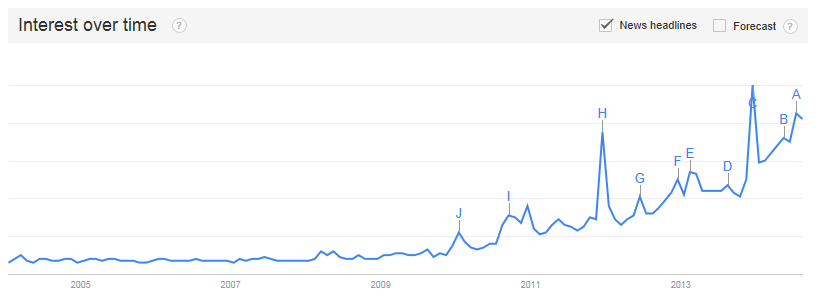For all of us who think Drones are things in sci-fiction or war movies used for spying on enemy’s territory, we would be surprised to know that Drones are being used for many civil/ commercial applications today and beyond the pizza delivery application that has re brought lot of interest in Drones lately. Some of them, though in the initial proof of concept phase, have been successfully able to prove that this technology is commercially and technically viable. Our imagination is our limit to visualize the applications for drones and how they can help multiple industries improve their efficiencies. There has been a lot of growing interest in Drones and related technologies over the last few years and this trend seems to be growing.
The Venture Capital funding received by Drone related start-ups in US is around $40 M in 2013 and most of these funds are related to hardware.

| Courtesy: Google Trends for “Drones” |
Given all the hype around Drones and their potential use cases, one can often wonder if Drones have the potential to disrupt the market and what are the technology evolutions that are promoting the future of Drones.
Technologies driving drones success:
UAV (Unmanned Aerial Vehicles) have been in existence for a long time now, however there seems to be a sudden hype for drones. In this section let us understand what is driving the need for drones. Like any disruptive innovation, Drones also reply on advancements in many fields that have enabled drones to come to reality. I have briefly outlines the various technology advancements here:
Digital Cameras: The most popular commercial use cases for drones, be it aerial photography or agriculture or aerial surveillance, rely on drones to provide high definition footages or images of objects of interest. Cameras have become much cheaper these days. There are a handful of truly affordable quadcopters, as cheap as $60, ready to fly and equipped with built-in cameras. For surveillance applications, HD cameras are typically used. These cameras are also equipped with on-board analytics like object detection and tracking. An example could be DARPA’s recently launched 1.8-gigapixel surveillance drone that can spot a terrorist from 20,000 feet.
Wireless Communication: Wireless communication has changed the world in many ways, many businesses today cannot survive without them being connected to their customers wirelessly. However, Wi-Fi is not still available universally. There are places where Wi-Fi may not be available. Drones are being used to bridge this gap by acting as Wi-Fi hot spots in places with no connectivity. Google acquired Titan Aerospace, a maker of high-altitude unmanned aerial vehicles (UAVs) and Facebook bought Ascenta. Both companies are looking at drones as an opportunity to deliver Internet access to the roughly five billion people who lack reliable land-based access today.
Computing Complexity and Analytics: For various applications, drones are used to collect data and communicate real-time intelligence to end users. For this purpose, drones have to be equipped with real time complex computing and analytics capabilities. Because most of the data collected by drones is in form of videos or images, the use of GPU or advanced CPUs for data processing has helped drones compute and communicate real time intelligence.
Internet of Things: Drones are an important end application for Internet of Things. They can be summoned to deliver things to end customers accurately and in-time. Near future applications could also include time critical delivery of medicines and other life saving supplied by drones and this can be possible only by including IoT capabilities in drones. Equipped with Wi-Fi, they can provide broadband connectivity on demand to places where it would otherwise be unavailable. Equipped with video cameras, they can show us what’s going on in locations where we might otherwise have to guess. Equipped with RFID antennas or sensors, they can help us track objects or people, or alert us to changing environmental conditions.
What’s next for drones?
As per the market study by Teal Group Corp. the worldwide spending on drones is expected to more than double over the next decade, and expected to be around $89 billion by 2023. The FAA estimates that as many as 7,500 small commercial drones to be operational in United States in the next 5 years.
Regulations may become a hurdle in full fledged adoption of drones for civil and commercial applications, however given the benefits of using UAV’s or drones their usage will become inevitable. The FAA, is also going to re-evaluate the rules on the commercial use of drones in 2015. It will take a while for the FAA to draw up rules for this, but all signs point to commercial drones as inevitability.
At eInfochips, we have expertise in various technologies listed in this blog. We have developed surveillance solutions that involve designing high definition cameras, communication gateways, algorithm development for parallelization including CUDA programming. We have tackled problems of inability of transmitting high definition video over low bandwidth communication links for Unmanned Aerial Vehicles in past. Learn how you can make difference in Civil, Military and Agricultural industry through operationalization of surveillance technology in UAV.











